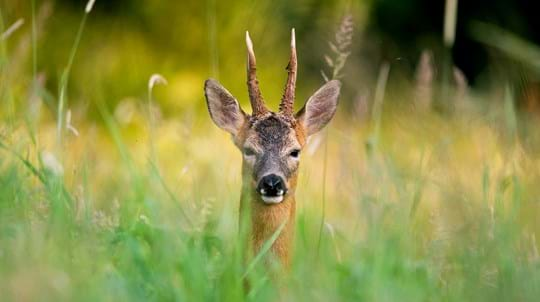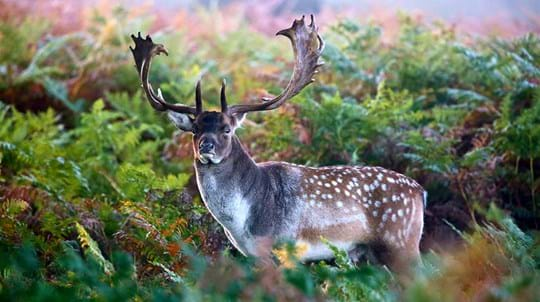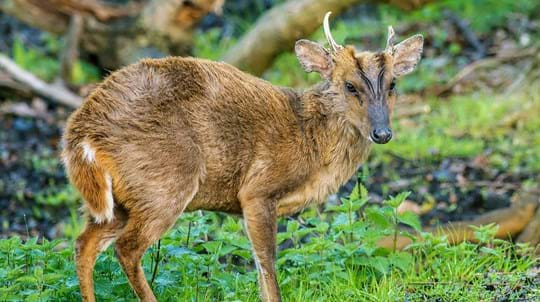
What do deer eat? What are antlers made of? And more deer facts
James Martin • 03 May 2019
From the dainty muntjac to the mighty red stag, the UK is home to six species of wild deer. Learn more about these fascinating creatures.
Read the blogThe majestic monarch of the glen. Our largest land mammal, red deer, are the royalty of UK woodland. Come autumn, the woods and hills echo with clashing antlers and the roars of rutting stags.
Common name:
red deer
Scientific name: Cervus elaphus
Family: Cervidae
Habitat: woodland, upland
Diet: grass, sedges, rushes, tree shoots and shrubs
Predators: adults no longer have natural predators; foxes and golden eagles may take young
Origin: native
Red deer have red-brown fur with a cream rump. The UK’s largest land mammal, a mature male (stag) may stand four feet tall at the shoulder and weigh up to 200kg.
Stags develop a large set of antlers that grow with age. Starting with just two points, the antlers steadily develop more branches, reaching up to 16 in most cases. These antlers are shed and regrown every year. Females (hinds) lack antlers and are more lightly built than males.
Not to be confused with: sika deer. Introduced from Asia, sika deer can look similar to red deer, but are significantly smaller. They have much darker brown fur in winter and develop white spots in summer.
Grasses are the primary food of red deer, but they will eat a range of plants, including tree shoots, sedges and rushes, herbs and shrubs.

James Martin • 03 May 2019
From the dainty muntjac to the mighty red stag, the UK is home to six species of wild deer. Learn more about these fascinating creatures.
Read the blog
Credit: Vince Burton / Alamy Stock Photo
From September to November, red deer enter the rut, with males fighting for access to hinds. A mature stag will attach himself to a group of females and attempt to see off any other males that wish to mate. Stags will roar loudly and thrash vegetation to intimidate rivals. If another stag is undeterred, the two will fight, locking antlers and pushing and twisting until the weaker of the two flees. These battles can lead to serious injuries and even death.
After mating with a dominant stag, hinds normally give birth to a single youngster, known as a calf, in late spring or early summer. Calves are born with a spotted coat to provide camouflage from predators. For the first few months of their life, they are left hidden in vegetation and only visited by their mother for short periods to suckle.
Outside the rut, males and females live separately. In open habitat, hinds and their young will gather in large herds, while stags live in loose bachelor groups. Deer are less social in woodland, typically living in smaller groups comprising a female and her young.

Credit: Geoff Scott-Simpson / naturepl.com
The majority of the UK’s red deer are found in Scotland. There are scattered populations across the rest of the country, with the greatest numbers in the Lake District, East Anglia and southwest England.
In much of England, Wales and southern Scotland, red deer are found in woodland, but the species also survives comfortably on the open hills and moors of Northern England and the Scottish Highlands.
Red deer are easiest to spot in open habitat and are a regular sight in the Scottish Highlands. However, the best way to see the species is in the many deer parks that exist across the UK. Park deer are only semi-wild and usually accustomed to humans, allowing for good views.
Deer in woodland are bigger than those in more open habitats because of the higher quality of food available.
The UK is home to six deer species, but only the red and roe deer are native. Hunting and loss of woodland meant red deer were rare by the end of the 18th century. However, numbers have grown considerably over the past 100 years, thanks to habitat changes and releases or escapes from deer parks.
While the recovery of the species is welcome, the absence of large carnivores in the UK means red deer have no natural predators. Consequently, deer density can reach extremely high levels, with total deer numbers in the UK thought to be at a 1,000-year high. This can have a significant negative impact on the environment, with overgrazing preventing the regeneration of woodland, thereby affecting woodland structure and tree-species composition. This has knock-on effects for other species of woodland flora and fauna. For this reason, some deer populations are culled to control their spread and reduce habitat damage.
Red deer numbers continue to grow, although the genetic purity of the species may be threatened by hybridisation with the non-native sika deer.

Trees woods and wildlife
Nimble and fleet of foot. The roe is our most widely distributed deer, found in woods across the country. Learn how to distinguish it from other deer, what it eats and where it lives.

Trees woods and wildlife
A social, elegant species with a signature speckled coat and mighty palmate antlers. The non-native fallow deer is now a regular sight in UK woodland. Find out what it eats, how it breeds and how to spot it.

Trees woods and wildlife
Small and secretive. Muntjac are an attractive, but potentially damaging, addition to our woodlands. Find out what they look like, what they eat and where they live.